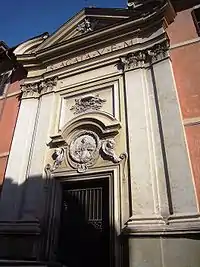Sant'Agata de' Goti, Rome
Sant'Agata dei Goti is a church in Rome, Italy, dedicated to the martyr Agatha of Sicily. It is the diaconia assigned to Cardinal Raymond Leo Burke, patron of the Sovereign Military Order of Malta.
| Sant'Agata de' Goti | |
|---|---|
| Sant'Agata in Subura, Sant'Agata in Monasterio, Sant'Agata de Caballo | |
Chiesa di Sant'Agata dei Goti | |
_-_Interior.jpg.webp) Interior of the church | |
 Sant'Agata de' Goti  Sant'Agata de' Goti | |
| 41°53′47.35″N 12°29′22.17″E | |
| Location | Via Mazzarino 16, Rome |
| Country | Italy |
| Denomination | Roman Catholic |
| Previous denomination | Arianism (until AD 592/593) |
| Tradition | Latin Rite |
| History | |
| Founder(s) | Ricimer |
| Dedication | Agatha of Sicily |
| Architecture | |
| Style | Baroque |
| Groundbreaking | c. 460 |
| Administration | |
| Diocese | Rome |
History
The church was built by Ricimer for the Goths c. 460. The Goths were Arians, so when Arianism was suppressed in Rome, the building was taken over by the Catholic Church, in 592 or 593, and reconsecrated by Pope Gregory the Great. It was restored in the 9th century, and a Benedictine monastery was founded next to it. The apse of the church collapsed in 1589, and it was partially rebuilt in 1633,[1] without major changes to the building itself apart from the new apse. The small courtyard outside the church was laid out at this time.
The church has been served by the Stigmatines since 1926. Their generalate is adjacent to it. It is the only Arian church that has been preserved in Rome.
Exterior

The Romanesque campanile was built in the 12th century. The façade was rebuilt by Francesco Ferrari in 1729. The relief above the door shows St. Agatha holding her severed breast on a plate; her torturers severed her breasts when she refused to renounce her faith in Christ.
The entrance from Via Mazzarino opens on a 17th-century courtyard. From 1836 to 1926, it belonged to the Irish College. Cardinal Paul Cullen, a former Rector of the Irish College, modelled the church of the Holy Cross College in Clonliffe in Dublin on the plans of St Agatha's.
Interior
Although it was redecorated in the Baroque style and has some 19th-century additions, it is still possible to see traces of the 5th-century plan, which was a basilica with three naves. The granite columns separating the naves are ancient.[1]
The fresco in the apse shows the Glory of St Agatha, made by Paolo Gismondi in the 17th century. There is a 12th- or 13th-century canopy above the altar, reassembled and erected here in 1933. It has four columns of pavonazzetto marble, all decorated with Cosmatesque mosaic, and a temple roof. The former canopy was destroyed in 1589; fragments can be seen in the ceiling of the main chapel on the left-hand side.
The 15th-century Cosmatesque pavement in the middle of the nave has an unusual, but very nice, design. It is a very late example of the style. The rectangular windows were installed in the 17th century at the request of the Cardinals Francesco and Antonio Barberini. By the altar of St Agatha is a large statue of the saint.
Ricimer, who was buried in the church, had a mosaic installed. This was unfortunately destroyed in 1589, when the apse collapsed. The Greek humanist John Lascaris (died 1535) is interred in the church and the heart of Daniel O'Connell, the 'Liberator' (died Genoa 1847), is buried here.[1]
Liturgy
The feast of the Greek martyrs whose relics are preserved here is on 2 December. It is usually celebrated with an evening Mass with the liturgy of the Byzantine Catholic rite.
Other important feasts are that of St Agatha on 5 February and St Gaspar Bertoni, founder of the Stigmatines, on 12 June.
Titulars
Pro illa vice, literally "for that turn", indicates a temporary appointment. In commendam indicates that a bishop who holds one title is also granted oversight of another vacant title. A titular see is an episcopal see of a former diocese. A titular see is generally conferred on a non-residential bishop such as an auxiliary bishop in another diocese, nuncios and members of the Curia, and occasionally, ordinaries who have resigned or retired from their primary see.[2]
|
|
References
- A Handbook of Rome and Its Environs. Rome: J. Murray. 1875. p. 152.
 This article incorporates text from this source, which is in the public domain.
This article incorporates text from this source, which is in the public domain. - Corrigan, Owen B., "Titular sees of the American hierarchy", The Catholic Historical Review, Washington DC: The Catholic University Of America, vol.6, issue 3, Oct 1920, pp. 322–323
 This article incorporates text from this source, which is in the public domain.
This article incorporates text from this source, which is in the public domain.
Sources
- Lucinda Byatt, "Sant'Agata dei Goti on the Quirinal: An Early Sixteenth-Century Fulcrum for Politics and Learning under Cardinal Ridolfi," Conference: Early Modern Rome 1341-1667, University of California Rome, 13-15 May 2010
- Burial of O'Connell's heart in Rome
| Wikimedia Commons has media related to Sant'Agata dei Goti (Rome). |